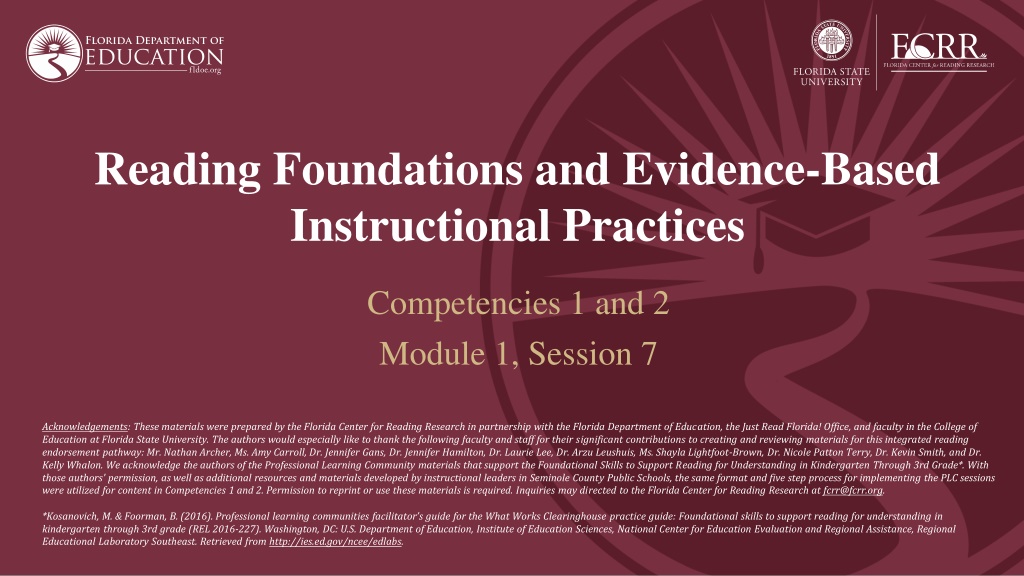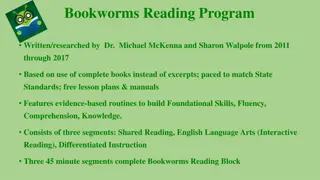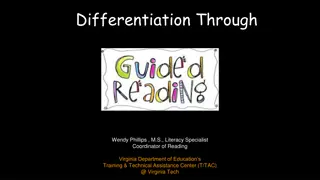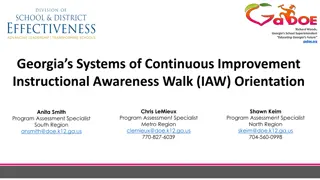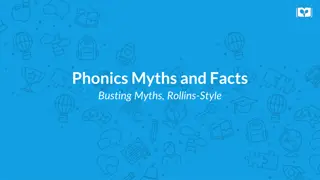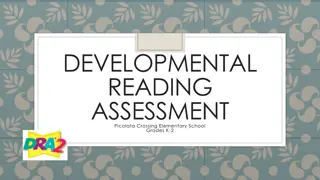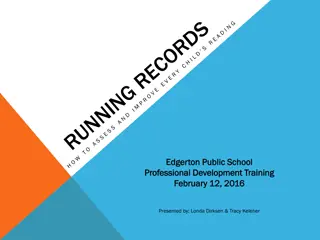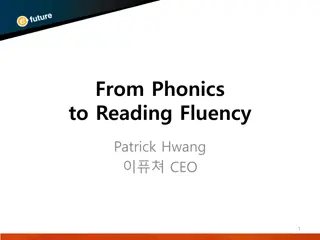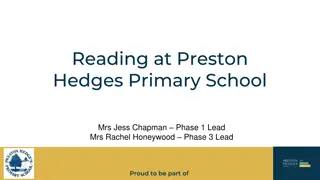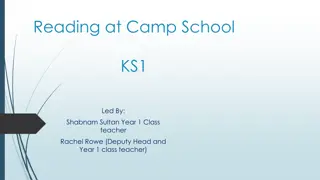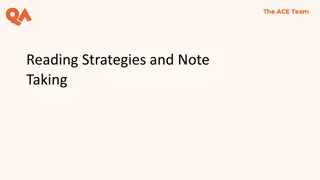Foundational Practices for Effective Reading Instruction
These materials were prepared by the Florida Center for Reading Research in collaboration with the Florida Department of Education and faculty from Florida State University. This module emphasizes teaching students to decode words, analyze word parts, and improve word recognition skills. Recommendations include developing academic language skills, building phonemic awareness, and enhancing reading accuracy, fluency, and comprehension. Session 7 focuses on common word parts and decoding strategies.
Download Presentation

Please find below an Image/Link to download the presentation.
The content on the website is provided AS IS for your information and personal use only. It may not be sold, licensed, or shared on other websites without obtaining consent from the author. Download presentation by click this link. If you encounter any issues during the download, it is possible that the publisher has removed the file from their server.
E N D
Presentation Transcript
Reading Foundations and Evidence-Based Instructional Practices Competencies 1 and 2 Module 1, Session 7 Acknowledgements: These materials were prepared by the Florida Center for Reading Research in partnership with the Florida Department of Education, the Just Read Florida! Office, and faculty in the College of Education at Florida State University. The authors would especially like to thank the following faculty and staff for their significant contributions to creating and reviewing materials for this integrated reading endorsement pathway: Mr. Nathan Archer, Ms. Amy Carroll, Dr. Jennifer Gans, Dr. Jennifer Hamilton, Dr. Laurie Lee, Dr. Arzu Leushuis, Ms. Shayla Lightfoot-Brown, Dr. Nicole Patton Terry, Dr. Kevin Smith, and Dr. Kelly Whalon. We acknowledge the authors of the Professional Learning Community materials that support the Foundational Skills to Support Reading for Understanding in Kindergarten Through 3rd Grade*. With those authors' permission, as well as additional resources and materials developed by instructional leaders in Seminole County Public Schools, the same format and five step process for implementing the PLC sessions were utilized for content in Competencies 1 and 2. Permission to reprint or use these materials is required. Inquiries may directed to the Florida Center for Reading Research at fcrr@fcrr.org. *Kosanovich, M. & Foorman, B. (2016). Professional learning communities facilitator s guide for the What Works Clearinghouse practice guide: Foundational skills to support reading for understanding in kindergarten through 3rd grade (REL 2016-227). Washington, DC: U.S. Department of Education, Institute of Education Sciences, National Center for Education Evaluation and Regional Assistance, Regional Educational Laboratory Southeast. Retrieved from http://ies.ed.gov/ncee/edlabs.
RECOMMENDATION THREE Teach students to decode words, analyze word parts, and write and recognize words.
Recommendations 1. Teach students academic language skills, including the use of inferential knowledge and narrative language, and vocabulary knowledge. 2. Develop awareness of the segments of sounds in speech and how they link to letters. 2. Teach students to decode words, analyze word parts, and write and recognize words. 4. reading accuracy, fluency, and comprehension. Ensure that each students read connected text every day to support
SESSION 7: COMMON WORD PARTS; DECODABLE WORDS Teach students to decode words, analyze word parts, and write and recognize words. How-to Step 3: Teach students to recognize common word parts. How-to Step 4: Have students read decodable words in isolation and in text.
Recommendation 3 addresses teaching students to decode words, analyze word parts, and write and recognize words. The previous PLC session covered How-to Step 1, Blending Words, and How-to Step 2, Common Sound-Spelling Patterns. The goal for this session is within the How-to Steps 3 and 4. How-to Step 3 addresses teaching students to recognize common word parts. How-to Step 4 addresses reading decodable words in isolation and in text. These steps are found on pages 26-28 of the practice guide. Discuss thoughts or questions about the recommendation and How-to steps.
Access Prior Knowledge: Discuss how you teach students to recognize common word parts (e.g., suffixes, contractions, prefixes, roots). Discuss how you engage students in reading decodable words in isolation and in text. What does that instruction look like? Discuss the challenges you are currently facing in teaching students to recognize common word parts. What challenges are you currently facing when teaching students to read decodable words in isolation and in text?
Move Into New Learning: How-to Step 3 addresses teaching students to recognize common word parts. Refer to pages 26-27 of the practice guide. Discuss: How do we help students learn how to analyze words? How does knowing how to analyze words by recognizing common word parts help students? What are examples of common word parts? What is one way to have students practice newly learned word parts? Discuss Example 3.5 on page 27.
Video 24: Base Word, Prefix, Suffix This video shows how to help students recognize common word parts by combining base words and affixes to make new words. Before the Video: Discuss the definitions of base word, prefix, suffix, affix. Refer to the glossary of the practice guide if needed. After the video: Discuss how you could use/adapt the strategy in the video to help students recognize base words, prefixes, and suffixes.
Video 25: Syllable Sort This video shows a way for students to practice recognizing common word parts by sorting words by syllable type. Before the video: Discuss the nature of conducting a word sort. Who uses word sorts in their classroom? Describe how you use word sorts. After the video: Discuss how you could use/adapt the strategy in the video to help students recognize syllables.
Video 26: Contractions This video shows a way for students to practice recognizing common word parts by forming contractions. Before the video: Discuss how participants teach contractions. After the video: Discuss how you could use/adapt the strategy in the video to help students recognize contractions.
Video 27: Derivational Suffix This video shows how derivational suffixes are added to common Latin/Greek vocabulary as a way for students to practice recognizing common word parts. Before the video: Discuss the definition and examples of a derivational suffix (a suffix is added to a root or base word to form another word: -ness in happiness, -able in floatable, -tion in education). After the video: Discuss how you could use/ adapt the strategy in the video to help students recognize derivational suffixes.
Video 28: Word Analysis Strategy This video illustrates the word analysis strategy found in Example 3.6 of the practice guide. Before the video: Review and discuss the word-analysis strategy found in Example 3.6 on page 27 of the practice guide. Discuss how you could use/adapt the strategy in the animation to help students use a word analysis strategy.
How-to Step 4 addresses teaching students to read decodable words in isolation and in text. Refer to page 28 of the practice guide. Discuss: What are ways to provide opportunities for students to practice the letter sounds and sound spelling patterns taught? Are there any techniques listed that you would like to incorporate into your instruction? Review Example 3.7 on page 28. Which sound spelling pattern have these students recently learned and are practicing in this example?
Video 29: Decodable Words in Isolation and in Text This video shows a teacher teaching a small group of first grade students. The students are practicing ee and ea (long-e) in isolation and in text. Review Activity 28: Video Viewing Guide, Decodable Words in Isolation and in Text. Focus on how the teacher taught and how the students practiced reading decodable words in isolation and in text. After the video: Refer to your video viewing guides and discuss how the teacher provided opportunities for the students to practice reading words in isolation and in text. What instructional components did you see in the video that matched the strategies described in the practice guide.
Compare Current Practice Discuss: The How-to Step 3 videos depicted ways in which students could practice recognizing common word parts. How are these techniques similar to or different from the way you currently teach students to recognize common word parts? The How-to Step 4 video illustrated a way to instruct students in reading decodable words in isolation and in text. How are the activities the teacher used in the video similar to or different from the way you currently have students read decodable words in isolation and in text?
Activity 1Common Word Parts Work in small groups of two or three and practice manipulating word parts with sound boxes using Activity 29: Manipulating Word Parts with Sound Boxes. Work with your group to complete the lesson plan. Share your word list and answer key with the whole group.
Activity 2: Decodable Words in Isolation and in Text Work in groups of two to three andreview Activity 30: Decodable Words in Isolation and in Text. Consider the text (Among the Trees) and answer the questions. Share with the whole group. Which letter sounds or sound spelling patterns could this text be used for students to practice reading decodable words in text? List the decodable words you would use from the text to teach in isolation. Which recommended strategies from How-to Step 4 would you use? Describe how you would teach these words in isolation and in text.
Activity 3: Word Analysis Strategy Separateinto small groups of two to three and practicethe word-analysis strategy found in Example 3.6 on page 27 of the practice guide. Example words that may be used if needed: adapting, preheated, compressing, attachment, informal. The word-analysis strategy consists of the following five steps: 1. Circle recognizable word parts. Look for prefixes at the beginning, suffixes at the end and other familiar word parts. 2. Underline the other vowels. 3. Say the different parts of the word. 4. Say them again fast to make it a real word. 5. Make sure the word makes sense in the sentence.
Reflect: Is there anything you learned during this session that either confirms or contradicts what you already knew about teaching students to recognize common word parts? What about to read decodable words in isolation and in text? Brainstorm ideas about what strategies you would add or change to teach students to recognize common word parts. Brainstorm ideas about what strategies you would add or change to teach students to read decodable words in isolation and in text. Discuss ideas for how to implement these additional strategies. What data will you use to determine whether the additions or changes you made resulted in improved student learning?
Implement: Develop and implement a lesson plan on teaching students to recognize common word parts and read decodable words in isolation and in text. Select common word parts that your students need to learn and describe how those word parts will be taught. A text will be selected that contains words that include those common word parts. The lesson plan will describe activities that will be used to have students read decodable words in isolation and in text. Activities used for this lesson plan are from the practice guide. Use Activity 31: Decodable Words in Isolation and in Text Lesson Plan Template to develop a lesson and then teach the lesson to students.
Implement: Complete Activity 32: Prepare to Share. Be prepared to respond to the following: Which common word parts did you target? How did you determine which skill(s) to teach? Which words did you select? Which text did you use? Why? How many students participated in the lesson? Describe the lesson you taught and the materials used. Did you teach the lesson as planned? If not, describe any adjustments you made and why you made them. How did your students respond to your instruction? How did you scaffold your instruction? How did you measure student learning?
